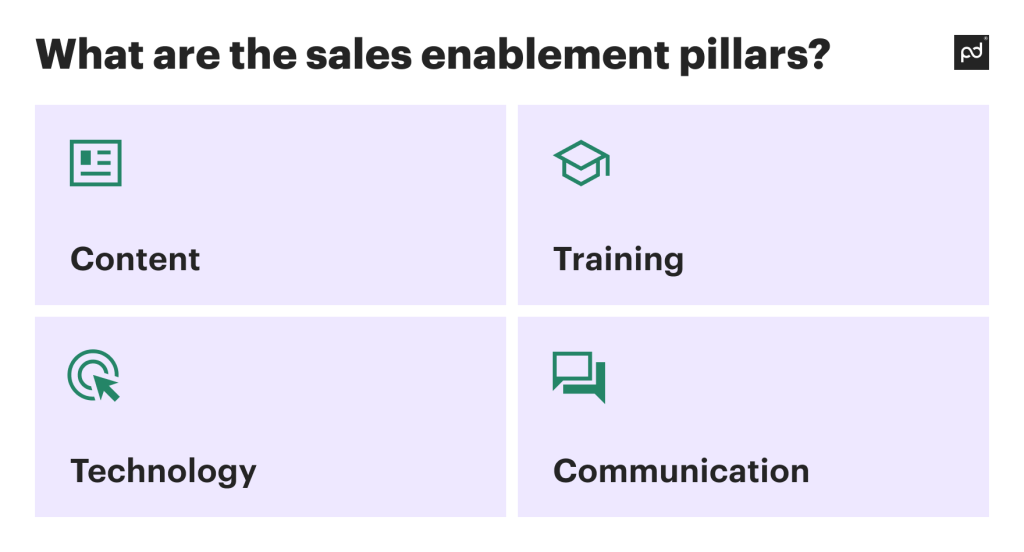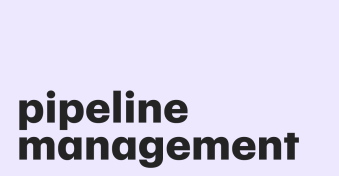Want to increase sales and boost your bottom line?
First, you must ensure that teams are properly equipped to meet these goals.
This article will focus on the sales enablement process, what it means for your organization, and how you can benefit from the approach.
Key takeaways
- Sales enablement equips sales and marketing teams with everything they need to succeed.
- It’s a different process to sales operations (which helps support the day-to-day functioning of sales) and encompasses much more than sales training.
- Sales enablement tools are essential for providing top-class support to your sales agents.
- PandaDoc’s sales enablement software is equipped with all the features you need.
What is sales enablement?
What does sales enablement do?
Sales enablement is a strategic approach that provides resources, tools, and training to empower sales teams, enhancing their effectiveness and efficiency throughout the sales process.
Take a look at your sales and marketing teams.
Can you honestly say that they are well-equipped to convert prospects? Sales enablement is all about answering ‘yes’ to this question.
Of course, sales enablement means more than providing the best equipment.
Whilst there is no single accepted definition of sales enablement, its concept is easy to grasp.
At its heart, it means your organization can align different functions as it encompasses multiple areas, including
- Providing learning resources to your teams
- Helping to improve the performance of individual team members
- Improving internal processes with automation and other tools
- Offering easy access to data so that teams can better interact with customers
What sales enablement isn’t
Sales enablement is sometimes used interchangeably with sales operations and sales training.
In reality, it’s an entirely different process (we’ll explain the differences in the next section).
Sales enablement is also not a one-time set of actions.
It’s not about ensuring teams are onboarded properly and sending them on their way.
Enablement means providing continuous support and adapting your approach to meet the needs of your employees.
Sales operations vs sales enablement: what’s the difference?
The sales operations team is separate from sales enablement.
As the name suggests, the team handles all the operational side of sales.
They’ll be in charge of looking after your customer relationship management software (CRM).
This involves tracking leads and sending follow-up reminders to agents.
If any errors occur with your CRM, the sales operations team will be the first hands on deck.
On the other hand, sales enablement ensures that the environment that the sales team operates in and the resources that support the team enable success.
Enablement vs sales training
There’s no denying that training is a big part of sales enablement. It’s important to note, though, that training is only an aspect of what this team provides.
As mentioned, enablement involves many different elements, including supplying the right tools and software.
Why is sales enablement important? The benefits
Sales enablement brings a long list of advantages to your organization.
The biggest, of course, is that it helps to produce more sales.
Sales teams have everything they need to succeed and can convert prospects more easily.
We’ve listed some examples of other benefits below.
Provides helpful content
Even the most seasoned sales team members need assistance sometimes.
Sales enablement means providing a library of helpful resources to aid agents.
This ranges from sales scripts to presentations and interactive quizzes.
Reduces mistakes
Mistakes can be costly and take time to correct.
Ensuring that agents are well-equipped and educated helps to reduce the risk of errors.
Saves time
Whether it’s stopping to ask questions or delays due to manual tasks, many elements can slow down agents.
Enablement helps to remove these roadblocks so that teams can focus on key tasks.
Empower teams
Enablement gives leaders greater confidence in their teams.
They’ll be more empowered to work towards success. Teams, in turn, will benefit from more effective leadership.
What are the sales enablement pillars?
We’ve separated the four key aspects of sales enablement.
Now, let’s look at these factors in more detail.

Content
This is a vital aspect of successful sales.
Sales enablement incorporates content management.
Some of the key aspects are outlined below:
Content should be clear and easy to find. This means prioritizing accessibility. If agents want to review materials in their downtime, they should be able to.
- It must be up to date. Outdated content will do little to help your team, and you’ll spend valuable time dealing with revisions.
- There should be a ‘single view of the truth.’ Different teams should all access the same resources and be given the same info.
- An effective content management system is essential. This should ensure that non-technical team members can publish content easily.
- Content should be appropriate and tailored to the needs of the sales team.
- Large volumes of irrelevant content must be avoided.
- Data insights and analytics should be used to improve future iterations of content creation. How are team members interacting with content? If, for instance, you find that members aren’t finishing articles, they may be too long.
Training
It’s easy to group good training with sales enablement.
Training is an important element. It will provide the knowledge and skills needed for the role.
Sales training techniques are varied and can be split into four groups.
Each addresses a slightly different area of sales.
Inside sales
For agents who engage in remote selling; on the phone, via video call, social media, or email.
Training focuses on winning the trust of customers and providing an effective sell.
Service sales
Focuses on building the customer’s lifetime value (LTV).
Looks at the best tactics for increasing LTV, such as consultative selling (an approach that focuses on building relationships with customers).
Sales management
As the name suggests, this training focuses on managers.
It equips them with skills to oversee teams effectively, including conflict management, effective communication, and more.
Field selling
For any agents that deal with door-to-door selling.
This includes improving face-to-face communication skills, lead identification, and more.
Again, training is only part of the picture.
Sales enablement requires the whole environment to be aligned for success.
Without ongoing coaching, strong content systems, organizational alignment, and the other practices within sales enablement, training won’t have the impact you need.
Technology
Sales enablement is about creating an environment where your sales team can be effective and efficient. An important element of this is aligning technology strategy with your sales objectives.
A range of tools is available that will assist reduce workload, improve effectiveness, and provide vital insights. These include:
Training and development
Modern packages deliver and supplement face-to-face training.
As well as supporting initial training, they can offer refreshments, updates, and new techniques and insights.
Customer engagement
These will help to develop relationships with customers, achieving higher and quicker sales.
Strategy development
The development of an effective strategy is key.
Software can help link strategy to sales objectives and define clear strategies and KPIs.
Planning and monitoring
Putting strategy into planning for all of the team.
Practice is easier with tools that generate detailed plans against which progress can be monitored.
They will produce reports that will highlight key points.
Content management systems
These deliver a library of content, providing version control and ensuring one version of the truth
Insights
Tools can provide visualizations, analysis, and insights into all aspects of sales performance.
This helps to identify and improve good practice and offers learning that can develop new strategies.
Communication
Communication, both internally amongst teams and with other departments such as marketing, are essential factors in sales.
Too often, though, barriers prevent agents from communicating effectively. Teams break into silos, and departments don’t see eye to eye.
It’s the job of sales enablement to ensure that these situations don’t arise.
This includes implementing new technology to centralize and streamline workflows.
It will work to encourage cross-department discussions and collaborations.
Of course, communication with prospects is an equally important factor for sales.
As mentioned, sales enablement provides teams with the resources and training to communicate with customers effectively.
How does the sales enablement process work?
Every sales enablement methodology is underpinned by a successful sales enablement strategy.
This should be built around factors like revenue goals and a business’ go-to-market strategy.
Most significantly, sales enablement should work towards aligning marketing and sales departments.
Once a strategy has been outlined, the enablement team usually carries out the following steps.
- Evaluate an organization’s existing CMS, identifying whether improvement is necessary. Sometimes, the team may decide to look for a new system entirely.
- Look at communication between teams and departments, and identify areas lacking. Once issues have been spotted, they can find ways to streamline communication.
- Find the best training programs to support staff development and progress towards goals.
4 best practices for sales enablement
As mentioned, sales enablement should be supported by an effective strategy.
When creating your roadmap to success, try to bear some of the following points in mind.
Spot high performers
Who are the most successful members of your sales team?
Consider both managerial and junior positions.
Use these high performers as blueprints. What are they doing right, how can others gain these benefits?
Set realistic expectations
Expecting a huge organizational shift overnight isn’t realistic.
Enablement should begin with small steps – then work your way up.
For example, instead of automating all processes at once, it’s better to begin with the most important.
Work for continuous growth
Enablement should mean more than a single training session.
To equip your staff with the best skills, learning needs to be constant.
Encourage agents to work towards self-improvement. Help them to identify new areas that they can work on.
Track your progress
Is your enable strategy working? The only way to find out is by tracking sales enablement metrics.
Try to find KPIs that align with the goals of your enablement strategy.
Examples include customer retention rates, first-call resolution rates, or buyer engagement.
Sales enablement examples
Let’s look at two imaginary but common examples of sales enablement.
Example #1
A member of your team is successfully acquiring leads but struggling to close them.
After identifying the issue, you send the employee on a course focusing on closing sales.
You also provide them with supportive scripts to help guide dialogue with clients.
The end result is a 50% increase in the agent’s lead close rate.
Example #2
After an evaluation, you find that your sales teams are hampered by repetitive admin tasks.
You identify that cutting out these tasks could bring a significant lift in revenue.
You introduce sales automation software as a solution.
Not only can this deal with admin, but also handle onboarding and other time-consuming tasks.
Who is responsible for sales enablement?
The sales enablement team is made up of enablement specialists and managers.
A sales enablement manager oversees teams and implements new strategies.
It’s their role to monitor data and adapt their approach when needed.
What is the role of a sales enablement specialist?
Sales enablement specialists carry out their manager’s initiatives.
They’ll ensure that day-to-day enablement tasks are carried out smoothly.
This includes assisting sales teams as they chase leads.
Enablement specialists also provide training and development for agents.
They’ll provide all the information about the latest products and initiatives of your organization.
They’ll also create electronic materials that sales can access whenever they need.
What skills do you need for sales enablement?
When hiring sales enablement specialists or managers, you need to make communication a top priority. After all, sales enablement will liaise with agents daily.
Not only that, but they’ll be in charge of training and coaching.
They’ll need the confidence to provide impactful sales training to agents.
Aside from communication, other essential skills include
- Ability to create effective and well-produced content to educate agents
- Familiarity with storing and managing content
- An analytical mind and ability to make data-based decisions
Sales enablement technology: what tools are needed?
Choosing the right tools is an integral part of sales enablement.
Without the right technology, you won’t be able to provide the support that sales need.
This means finding the best platform to meet your needs.
When choosing sales enablement software, look for some of the following features.
- The ability to communicate with teammates effectively and leave comments on documents
- Document creation that allows you to easily create interactive documents
- The ability to automate repetitive data entry tasks
- Track how customers interact with sales documents so that agents can provide the best support
Use PandaDoc’s sales enablement software to grow your business
Sales enablement is a crucial part of every modern sales team.
Without it, agents don’t have the skills, technology, or resources to close leads.
But as we’ve explored, an enablement strategy needs to be supported by the right tools.
PandaDoc’s sales enablement software includes all the above features (and more!).
You can empower your team with tools that reduce document creation time by 50% and increase close rates by 36%.
With comprehensive analytics, you can get all the information you need to guide your enablement strategy.
Want to see it for yourself? Why not request a demo today?
Disclaimer
PandaDoc is not a law firm, or a substitute for an attorney or law firm. This page is not intended to and does not provide legal advice. Should you have legal questions on the validity of e-signatures or digital signatures and the enforceability thereof, please consult with an attorney or law firm. Use of PandaDoc services are governed by our Terms of Use and Privacy Policy.


